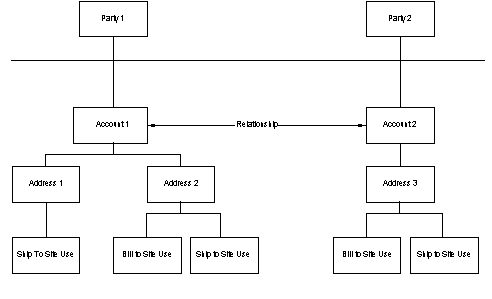You can model customers and customer details using Oracle's Trading Community model. Oracle's Trading Community customer model is a powerful customer architectural design, building on the Receivables Customer model, enabling users to now define and maintain customer hierarchies and relationships between customers and sites. If a CRM or ERP application maintains customer information, the application is using the Trading Community customer model.
Trading Community enables you to:
- Separate entities you enter into a relationship with, from the business relationship itself
- Provide a common location entity that can be shared, enabling greater optimization for distributed planning
- Maintain businesses and people as different entity types
- Enables multiple customer relationships to be established for one common entity
Terminology
Trading Community
- Party: This is a generic term for any entity which can have any type of relationship with your company. The three primary party types are:
- Person: This party type is typically used when you are creating an entity that operates within a business to customer environment.
- Organization: This party type is typically used when you are creating an entity that operates within a business to business environment.
- Party Relationship: This party type represents a binary relationship between two parties such as a partnership. Party relationship types can be seeded or user-defined. A party relationship is optionally a party itself, meaning certain party relationships can enter into relationships themselves (currently not supported within Order Management).
- Party Site: Party Site represents the link between a party and a location (a valid location for the party. Typically, your organizational hierarchy is used when modeling using party relationships.
- Account: An account represents a relationship between your company and a party in the Trading Community model who is your customer. Accounts contain the attributes of the selling relationship between your organization and a party. Account attributes do not describe a party; they only exist when a selling relationship is present between the your organization and a party. The information which is used for processing orders and receivables transactions is part of the account information.
- Account Site: A party site address that is used within the context of an account.
- Account Site Usage: An account site created for specific usage; for example, billing or shipping purposes. If a new account site usage is created for a Customer, then that Account Site Usage will be marked as Primary.
Mapping Order Management terminology to Trading Community terminology
- Customer Site, Customer Location, Customer Address: These terms, within Order Management equate to Trading Community Account Sites.
- Bill To, Ship To, Deliver To: These terms, within Order Management, equate to Trading Community Account Sites Usages.
The following figure describes the conceptual usage of the Trading Community model as utilized currently within Order Management.

Within Order Management, each account belongs to a party. These parties may have additional relationships and details defined, but Order Management currently only utilizes a limited subset of the party data (accounts, addresses, and sites usages).
The Trading Community model includes all the information which was previously stored in the Receivables customer model. This includes information such as:
- Customers
- Customer addresses and site uses
- Profile amounts
- Customer relationships
As Order Management adds new features and additional functionality to its core application, users will begin to see Trading Community terminology incorporated into Order Management Forms (windows), Reports, Concurrent Programs, and product documentation. Until these project are completed, Order Management forms will continue to use names of entities as they existed in the Receivables customer database tables. The following table provides a mapping of these field names.
| Order Management Form (window) Entity Name | Trading Community Base Table Entity Name |
|---|---|
| Customer Number | Account Number |
| Customer Name | Party Name |

No comments:
Post a Comment